Bubble-tip anemones, also known scientifically as Entacmaea quadricolor, are a species of sea anemone often paired in aquariums with different types of clownfish.
They are incredibly beautiful and come in a variety of colors such as brown, green, orange, red, and rose pink. While clownfish are a relatively easy fish for aquarists to care for, the invertebrate anemones are more challenging to keep.
If they are to thrive, they need very particular lighting, stability, and water flow requirements, coupled with specific supplemental feeding protocols.
In this guide, we focus on the easiest species of anemones to keep as well as those most prone to clownfish hosting—bubble-tip anemones.
We delve deeper into bubble-tip anemone care and give saltwater aquarists the proper instructions to care for bubble-tip anemones. Keep reading as we explore their proper feeding routines, lighting parameters, water flow, and gravity requirements, among other things.
The Challenge of Caring for Anemones
It may surprise you to know that although these invertebrates look like corals, bubble-tip anemones are more closely related to jellyfish than corals. Just like jellyfish, they are single-celled animals—and therefore more sensitive to chemical and light changes.
These inverts need lots of light, in the PAR of 200-350µmol, similar in levels to SPS corals. They need good LED lighting to thrive because they contain zooxanthellae algae in their tissues, which enable them to photosynthesize.
As a rule, 4-6 watts per gallon of 14,000K or higher should be a perfect lighting starting point for 20-inch tanks, good enough to keep these inverts healthy.
Bubble-tip anemones require a lot of stability to thrive, so ideally, do not place them into a tank you’ve just purchased. We recommend that you wait at least six months before you add one of these inverts since that is enough time to get a healthy amount of coralline algae growth, which indicates that your reef tank has achieved stability.
Anemones are territory-sensitive and will sting any corals in their space. As an essential part of bubble-tip anemone care, if you notice that your invert has moved near corals, move the corals out of the way within 24-48 hours.
That said, these animals do move around a lot in general. You’ll need to oversee their movements in the tank as they tend to get stuck on the wavemaker, which can be fatal.
Why Bubble Tip Anemones Are Great First-Time Anemones
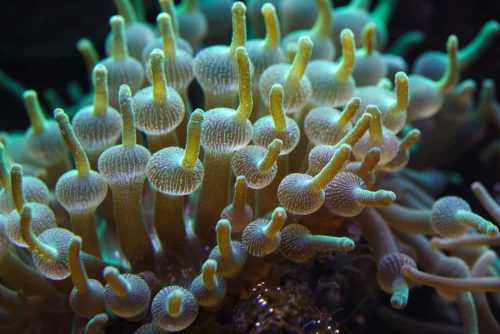
Bubble-tip anemones are excellent first-time anemones because they are easier to propagate and maintain. Besides looking great and adding exotic color to your reef tank, these creatures are an easier anemone to reproduce. They are incredibly affordable, too.
However, failure to meet these creatures’ needs could easily lead to their deaths. If you, as a first-time saltwater aquarist, miscalculate the pristine conditions, water changes, and feeding routines needed for your anemones to thrive, and lose your anemones, you can easily replace them with other inverts.
Bubble Tip Anemone Care – Feeding, Flow, Lighting, & Selection
Newbie and seasoned aquarists dream of owning these incredible-looking invertebrates since they are colorful, mesmerizing, and a joy to behold.
However, you’ll need to ensure that you create a stable environment in which they can grow, providing the proper feeding, flow, lighting, and selection to maximize their health.
Feeding: What Do Anemones Eat?
Bubble-tip anemones are photosynthetic, which means that they need light to create food from which they get their nutrients. They are also predatory and will prey naturally on other animals.
However, these creatures also eat food from any fish they host and still require occasional supplemental feeding to maintain their overall health and color. Protein snacks may include small morsels of freeze-dried:
- Brine shrimp
- Crab
- LRS reef frenzy
- Krill
- Mysis shrimp
- Silversides
Feed your bubble-tip anemones a couple of times a week if they are in the reef tank alone.
During feeding, always ensure that you thaw the food before giving it to them. Attach the morsel to clean tweezers or a stick and then gently touch the anemone with it. The anemone will use its tentacles to feed.
If you’ve paired your anemone with any fish in your reef tank, you can reduce the feeding routine since the fish in the tank will provide adequate nourishment.
Optimizing Flow for Your Bubble Tip Anemone

Aquarists agree that too much flow can cause the anemone to stretch out and look stringy—these creatures enjoy a moderate current.
Never direct jets at the anemone since the direct flow will force them to move and damage your reef tank. Also, ensure that you get adequate covers for your wavemakers to prevent the anemone from jamming them if they move within the reef tank.
Bubble-tip anemones prefer warmer, alkaline waters. Maintain temperatures of 72°F-82°F, pH levels of 8.1-8.4, a water hardness of 8-12 dKH, and a specific gravity of 1.023 to 1.025 to ensure that your creatures thrive.
Anemones also prefer water that’s free of organic waste, so you’ll need to invest in a protein skimmer and regularly change the water to maintain the proper levels of trace elements such as iron supplements that specifically benefit the zooxanthellae algae.
Lighting for Your Bubble Tip Anemone
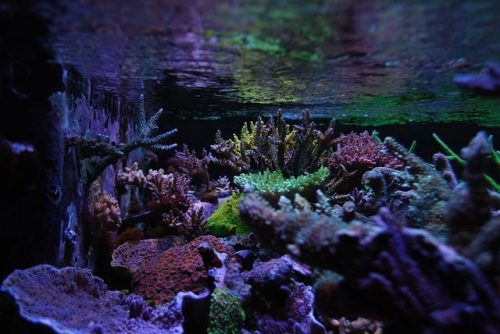
Lighting is an essential aspect of bubble-tip anemone care.
These creatures need lots of light to thrive because they’re partly photosynthetic and need light to synthesize their food. They also have a symbiotic relationship with zooxanthellae, which live inside their bodies and on which they feed.
Without proper LED lighting, bubble-tip anemones will “bleach,” a fatal process in which they expel the zooxanthellae from their bodies and turn white.
To achieve the proper lighting levels of 220 – 350PAR, you may use fluorescent bulbs, LED lights, or even metal halide lights. Be sure that you keep the lights on for 12 hours each day for the proper development of your invert.
Selecting Your Bubble Tip Anemone
A crucial part of bubble-tip anemone care is the proper selection. Always choose an aqua-cultured anemone over a wild one as these tend to thrive better in reef tanks, are more affordable, and have a less potent sting.
When choosing your specimen, always opt for those that have:
- Puckered or closed mouths
- A firm grip of the glass or substrate
- A healthy, intact base
- A smaller size, ideally 3-4 inches in diameter
- Healthy, inflated tentacles
Remember, if your bubble-tip anemone is not attached to substrate or glass in the dealer’s reef tank, it may very well have difficulty attaching to your reef tank. You should also observe as your dealer handles your anemone—if it doesn’t react or contract, it isn’t robust and most likely won’t survive long.
And finally, your anemone should be slightly sticky to the touch. This quality means that it can still fire its nematocysts or stinging cells and be easier to feed.
The Types of Anemones
Bubble-tip anemones are unique creatures that possess short tentacles with a bulbous tip. These tentacles can elongate or contract, depending on the changes in their environment. Interestingly, anemones that grow in deeper sea waters with less light tend to have longer tentacles.
Below the tentacles is the anemone’s base or foot, composed of muscles that help the creature move or anchor onto rocks. This area is incredibly delicate—and, when ruptured, can be fatal.
Several bubble-tip anemone types are available in the market, and they come in a variety of shapes, sizes, and colors:
Carpet Anemones
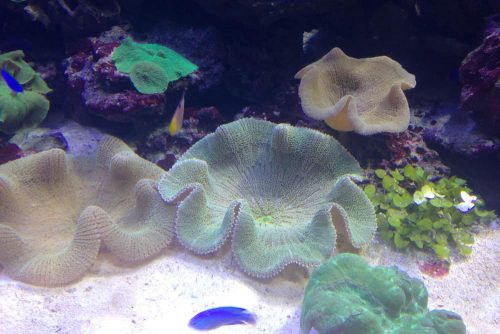
Carpet anemones are giant, striking, hardy, and quite deadly.
They only feed on fish. These creatures have a high mortality rate, with over 90% dying within the first year. We would not recommend carpet anemones for beginner aquarists because of these factors.
Long-Tentacle Anemones

Long-tentacle anemones or corkscrew anemones are much like carpet anemones as they require perfect water conditions to thrive. These are quite large and don’t need as much light but are extremely sensitive to changes. Again, we would not recommend this variety for beginners since they are quite challenging.
Rock Flower Anemones
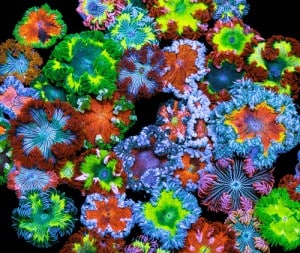
These colorful anemones are naturally found in the Caribbean and are simple to keep. However, their only disadvantage is that clownfish won’t host them.
They are excellent for adding exotic color to your reef tank and make terrific first-time picks.
However, they will aggressively sting corals near them and tend to move a lot in the tank until they find a comfortable spot.
Sebae Anemones

Sebae anemones are a colorful anemone typically hosted by the maroon clownfish. They prefer to anchor on sand instead of rock and require near-perfect water conditions to thrive. To give them a strong chance of survival, create deeper sand beds for them to anchor. They do not ship well and are one of the more difficult anemones to maintain.
Popular Bubble Tip Anemones
Black Widow Bubble Tip Anemone

Black widow bubble-tip anemones are incredibly rare and can cost hundreds of dollars to acquire.
They have a striking blood-red color, which provides a beautiful contrast. Pair this anemone with contrasting fish in your reef tank for maximum effect.
Green Bubble Tip Anemone
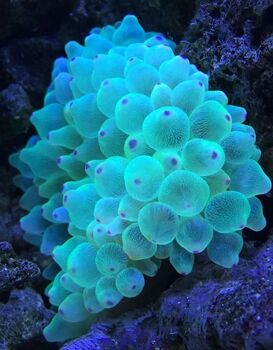
Green bubble-tip anemones are incredibly affordable and readily available.
The tentacles have a distinct greenish-blue color that blends in nicely with surrounding rocks and foliage. Under the right lighting, they can produce a pleasant and calming glow.
Rainbow Bubble Tip Anemone
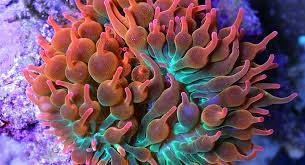
Rainbow bubble-tip anemones are an impressive variety of anemone as they have a vibrant neon blue base that fades into a rose color on the tentacles tips.
This beautiful variety can be expensive but adds lots of exotic color to your reef tank.
Rose Bubble Tip Anemone
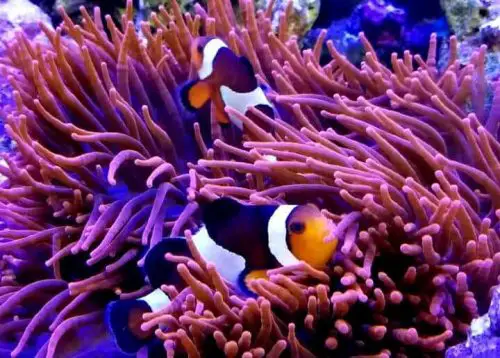
Rose bubble-tip anemones are even more common than the green-tipped variety. What’s more, they are prolific propagators.
Because of these factors, they are popular with saltwater aquarists since they are readily available, easy to sell after propagation, and make an excellent option for first-time hobbyists.
Propagating Bubble Tip Anemones Can Be Profitable
Bubble-tip anemones are one of the best species of anemones for saltwater aquarists to propagate. These creatures are in high demand in pet stores, and many aquarists are happy to buy domestic anemone splits as these tend to do better in reef tanks than wild splits.
The reasons why these creatures split vary, but the two main reasons are:
- Feeding-induced splits
- Stress-induced splits
Let’s delve deeper into these splits to help you understand them better.
The Right Way: Feed-Induced Splitting
Proper and regular feeding is an excellent way to get anemones to split faster. The nutrients help them to grow well and split naturally, which leads to sound propagation.
The more you feed your bubble-tip anemone, the faster it will grow. Provide small snacks each day until your specimen reaches approximately 12 inches in size, at which point in growth it will naturally split into smaller pieces that you can propagate.
This video shows a time-lapse of an anemone splitting naturally, for your reference.
The Wrong Way: Stress-Induced Splitting
As with any animal, when stressed, anemones trigger a survival instinct and split to preserve themselves.
Excessive splitting may confuse amateur aquarists if they mistake it for thriving. Should this happen with your bubble-tip anemone, check the salinity, lighting, or nutrient levels in the water since these may be off, leading your bubble-tip anemone to be splitting like crazy.
As much as possible, use feed-induced splitting if propagating your anemone, because stress-induced splitting is cruel on the invert.
Bubble Tip Anemone Quarantine
Anemones are some of the most relaxed animals to keep as they do not host parasites. These creatures lack the hard surfaces for parasites to hold on to, and many parasites can’t survive the creature’s sting.
Because anemones only host free swimmers, any parasites will die in approximately 16 days in a quarantine system without fish, which is less than the standard 45-76 days recommended for coral quarantine.
Bear in mind that you’ll need to have all the lighting and water parameters correct, and be sure to cover all powerheads and filters since the bubble-tip anemone will move during the quarantine.
Some aquarists prefer not to quarantine their anemone, but we do not recommend this course of action. If you prefer not to isolate your anemone, rinse the invert in the display water to get as much of the former tank water out of it—and then drop it into your reef tank.
Bubble Tip Anemone Care: Conclusion
Bubble-tip anemone care is manageable and is something aspiring aquarists should try. These creatures are low activity (which makes them easier to care for), mesmerizing to look at, and bring exotic, vibrant color to your home.
Ensure that you follow the recommended feeding, lighting, water, flow, and selection guidelines to keep your bubble anemones thriving.
If you have any queries on any of the points we’ve covered in this guide or if you are still on the fence about getting bubble-tip anemones and need more convincing, we’d love to hear from you!
Best of luck in giving the best care to these beautiful creatures.

